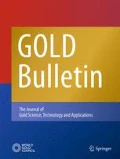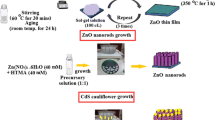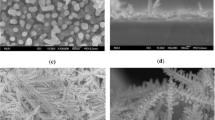Abstract
Photoelectrochemical cell composed of solution-processed nanoflower heterostructure of Au core and eight CdSe petals was investigated for enhanced photocurrent generation. The electrode of CdSe nanorods displayed photocurrent density of 2.1 mA/cm2 whereas the Au core CdSe nanoflower exhibited 4.6 mA/cm2 corresponding to a 119% increase during photoelectrochemical cell performance. Both electrodes showed prompt response to the on/off cycles of light, the photocurrent gain (IPhoton/Idark) in CdSe nanorods is 124.7, while the value is 223.3 for Au/CdSe nanoflower, calculated from the growth-decay curves. Photoresponse time was dramatically improved for Au/CdSe nanoflower samples due to increasing in 66% incident photon-to-current emission. Electron lifetime of 21.63 and 48.71 ns was observed for the electrode of CdSe nanorods and Au/CdSe nanoflowers respectively. The prolonged electron lifetime in the case of the electrode of Au/CdSe nanoflowers was responsible for improving charge separation and as a consequence, higher photocurrent generation.




Similar content being viewed by others
References
Lewis NS (2007) Toward cost-effective solar energy use. Science 315:798–801
Lu Q, Yu Y, Ma Q, Chen B, Zhang H (2016) 2D transition-metal-dichalcogenide-nanosheet-based composites for photocatalytic and electrocatalytic hydrogen evolution reactions. Adv Mater 28:1917–1933
Kim HJ, Lee SH, Upadhye AA, Ro I, Tejedor-Tejedor MI, Anderson MA, Kim WB, Huber GW (2014) Plasmon-enhanced photoelectrochemical water splitting with size-controllable gold nanodot arrays. ACS Nano 8:10756–10765
Jiang F, Harada T, Kuang Y, Minegishi T, Domen K, Ikeda S (2015) Pt/In2S3/CdS/Cu2ZnSnS4 thin film as an efficient and stable photocathode for water reduction under sunlight radiation. J Am Chem Soc 137:13691–13697
Gao L, Cui Y, Wang J, Cavalli A, Standing A, Vu TT, Notten PH (2014) Photoelectrochemical hydrogen production on InP nanowire arrays with molybdenum sulfide electrocatalysts. Nano Lett 14:715–3719
Srivastava S, Thomas JP, Rahman MA, Abd-Ellah M, Mohapatra M, Pradhan D, Leung KT (2014) Size-selected TiO2 nanocluster catalysts for efficient photoelectrochemical water splitting. ACS Nano 8:11891–11898
Rahman MA, Bazargan S, Srivastava S, Wang X, Abd-Ellah M, Thomas JP, Leung KT (2015) Defect-rich decorated TiO2 nanowires for super-efficient photoelectrochemical water splitting driven by visible light. Energy Environ Sci 8:3363–3373
Basu M, Zhang ZW, Chen CJ, Chen PT, Yang KC, Ma CG, Liu RS (2015) Heterostructure of Si and CoSe2: a promising photocathode based on a non-noble metal catalyst for photoelectrochemical hydrogen evolution. Angew Chem 54:6211–6216
Gray HB (2009) Powering the planet with solar fuel. Nat Chem 1:7
Zhang L, Minegishi T, Nakabayashi M, Suzuki Y, Seki K, Shibata N, Domen K (2015) Durable hydrogen evolution from water driven by sunlight using (Ag, Cu) GaSe2 photocathodes modified with CdS and CuGa3Se5. Chem Sci 6:894–901
Kaga H, Tsutsui Y, Nagane A, Iwase A, Kudo A (2015) An effect of Ag (i)-substitution at Cu sites in CuGaS2 on photocatalytic and photoelectrochemical properties for solar hydrogen evolution. J Mater Chem A 3:21815–21823
Moriya M, Minegishi T, Kumagai H, Katayama M, Kubota J, Domen K (2013) Stable hydrogen evolution from CdS-modified CuGaSe2 photoelectrode under visible-light irradiation. J Am Chem Soc 135:3733–3735
Li X, Yu J, Low J, Fang Y, Xiao J, Chen X (2015) Engineering heterogeneous semiconductors for solar water splitting. J Mater Chem A 3:2485–2534
Marschall R (2014) Semiconductor composites: strategies for enhancing charge carrier separation to improve photocatalytic activity. Adv Funct Mater 24:2421–2440
Zandi O, Hamann TW (2014) Enhanced water splitting efficiency through selective surface state removal. J Phys Chem Lett 5:1522–1526
Kuo CH, Yang YC, Gwo S, Huang MH (2010) Facet-dependent and Au nanocrystal-enhanced electrical and photocatalytic properties of Au-Cu2O Core-shell heterostructures. J Am Chem Soc 133:1052–1057
Yu X, Shavel A, An X, Luo Z, Ibáñez M, Cabot A (2014) Cu2ZnSnS4-Pt and Cu2ZnSnS4-Au heterostructured nanoparticles for photocatalytic water splitting and pollutant degradation. J Am Chem Soc 136:9236–9239
Patra BK, Shit A, Guria AK, Sarkar S, Prusty G, Pradhan N (2015) Coincident site epitaxy at the junction of Au–Cu2ZnSnS4 heteronanostructures. Chem Mater 27:650–657
Shaviv E, Schubert O, Alves-Santos M, Goldoni G, Di Felice R, Vallee F, Sönnichsen C (2011) Absorption properties of metal–semiconductor hybrid nanoparticles. ACS Nano 5:4712–4719
Costi R, Saunders AE, Banin U (2010) Colloidal hybrid nanostructures: a new type of functional materials. Angew Chem Int Ed 49:4878–4897
Haldar KK, Muley VY, Datar S, Patra A (2017) Structural and electronic investigation of metal-semiconductor hybrid tetrapod hetero-structures. Gold Bull 50:105–110
Banin U, Ben-Shahar Y, Vinokurov K (2013) Hybrid semiconductor–metal nanoparticles: from architecture to function. Chem Mater 26:97–110
Kim Y, Park KY, Jang DM, Song YM, Kim HS, Cho YJ, Park J (2010) Synthesis of Au- Cu2S core-shell nanocrystals and their photocatalytic and electrocatalytic activity. J Phys Chem C 114:22141–22146
Patra BK, Khilari S, Pradhan D, Pradhan N (2016) Hybrid dot–disk Au-CuInS2 nanostructures as active photocathode for efficient evolution of hydrogen from water. Chem Mater 28:4358–4366
Manna G, Bose R, Pradhan N (2014) Photocatalytic Au–Bi2S3 heteronanostructures. Angew Chem Int Ed 53:6743–6746
Seh ZW, Liu S, Low M, Zhang SY, Liu Z, Mlayah A, Han MY (2012) Janus Au-TiO2 photocatalysts with strong localization of plasmonic near-fields for efficient visible-light hydrogen generation. Adv Mater 24:2310–2314
Jiang R, Li B, Fang C, Wang J (2014) Metal/semiconductor hybrid nanostructures for plasmon-enhanced applications. Adv Mater 26:5274–5309
Yen YT, Chen CW, Fang M, Chen YZ, Lai CC, Hsu CH, Ho JC (2015) Thermoplasmonics-assisted nanoheterostructured au-decorated CuInS2 nanoparticles: matching solar spectrum absorption and its application on selective distillation of non-polar solvent systems by thermal solar energy. Nano Energy 15:470–478
Scarfiello R, Nobile C, Cozzoli PD (2016) Colloidal magnetic heterostructured nanocrystals with asymmetric topologies: seeded-growth synthetic routes and formation mechanisms. Front Mater 3:56
Carbone L, Cozzoli PD (2010) Colloidal heterostructured nanocrystals: synthesis and growth mechanisms. Nano Today 5:449–493
Deka S, Falqui A, Bertoni G, Sangregorio C, Poneti G, Morello G, Cozzoli PD (2009) Fluorescent asymmetrically cobalt-tipped CdSe@ CdS core@ shell nanorod heterostructures exhibiting room-temperature ferromagnetic behavior. J Am Chem Soc 131:12817–12828
Casavola M, Falqui A, García MA, García-Hernández M, Giannini C, Cingolani R, Cozzoli PD (2008) Exchange-coupled bimagnetic cobalt/iron oxide branched nanocrystal heterostructures. Nano Lett 9:366–376
Morello G, Anni M, Cozzoli PD, Manna L, Cingolani R, De Giorgi M (2007) Picosecond photoluminescence decay time in colloidal nanocrystals: the role of intrinsic and surface states. J Phys Chem C 111:10541–10545
HuangL RF, Rudolph M, Hashmi ASK (2016) A general access to organogold (III) complexes by oxidative addition of diazonium salts. Chem Commun 52:6435–6438
Huang L, Rudolph M, Rominger F, Hashmi ASK (2016) Photosensitizer-free visible-light-mediated gold-catalyzed 1, 2-difunctionalization of alkynes. Angew Chem Int Ed 55:4808–4813
Witzel S, Xie J, Rudolph M, Hashmi ASK (2017) Photosensitizer-free, gold-catalyzed C–C cross-coupling of boronic acids and diazonium salts enabled by visible light. Adv Synth Catal 359:1522–1528
Xie J, Shi S, Zhang T, Mehrkens N, Rudolph M, Hashmi ASK (2015) A highly efficient gold-catalyzed photoredox α-C (sp3)-H alkynylation of tertiary aliphatic amines with sunlight. Angew Chem Int Ed 54:6046–6050
Xie J, Zhang T, Chen F, Mehrkens N, Rominger F, Rudolph M, Hashmi ASK (2016) Gold-catalyzed highly selective photoredox C (sp2)−H difluoroalkylation and perfluoroalkylation of hydrazones. Angew Chem Int Ed 55:2934–2938
Xie J, Li J, Weingand V, Rudolph M, Hashmi ASK (2016) Intermolecular photocatalyzed heck-like coupling of unactivated alkyl bromides by a dinuclear gold complex. Chem Eur J 22:12646–12650
Hashmi ASK, Hutchings GJ (2006) Gold catalysis. Angew Chem Int Ed 45:7896–7936
Khon E, Mereshchenko A, Tarnovsky AN, Acharya K, Klinkova A, Hewa-Kasakarage NN, Zamkov M (2011) Suppression of the plasmon resonance in Au/CdS colloidal nanocomposites. Nano Lett 11:1792–1799
Nishijima Y, Ueno K, Yokota Y, Murakoshi K, Misawa H (2010) Plasmon-assisted photocurrent generation from visible to near-infrared wavelength using a Au-nanorods/TiO2 electrode. J Phys Chem Lett 1:2031–2036
Dutta SK, Mehetor SK, Pradhan N (2015) Metal semiconductor heterostructures for photocatalytic conversion of light energy. J Phys Chem Lett 6:936–944
Lee JS, Shevchenko EV, Talapin DV (2008) Au−PbS core−shell nanocrystals: plasmonic absorption enhancement and electrical doping via intra-particle charge transfer. J Am Chem Soc 130:9673–9675
Patra BK, Guria AK, Dutta A, Shit A, Pradhan N (2014) Au-SnS hetero nanostructures: size of Au matters. Chem Mater 26:7194–7200
Li M, Yu XF, Liang S, Peng XN, Yang ZJ, Wang YL, Wang QQ (2011) Synthesis of Au–CdS core–shell hetero-nanorods with efficient exciton–plasmon interactions. Adv Funct Mater 21:1788–1794
Cozzoli PD, Pellegrino T, Manna L (2006) Synthesis, properties and perspectives of hybrid nanocrystal structures. Chem Soc Rev 35:1195–1208
Costi R, Saunders AE, Elmalem E, Salant A, Banin U (2008) Visible light-induced charge retention and photocatalysis with hybrid CdSe−Au nanodumbbells. Nano Lett 8:637–641
Haldar KK, Sinha G, Lahtinen J, Patra A (2012) Hybrid colloidal Au-CdSe pentapod heterostructures synthesis and their photocatalytic properties. ACS Appl Mater Interfaces 4:6266–6272
Sigle DO, Zhang L, Ithurria S, Dubertret B, Baumberg JJ (2015) Ultrathin CdSe in plasmonic nanogaps for enhanced photocatalytic water splitting. J Phys Chem Lett 6:1099–1103
Liu L, Wang G, Li Y, Li Y, Zhang JZ (2011) CdSe quantum dot-sensitized Au/TiO2 hybrid mesoporous films and their enhanced photoelectrochemical performance. Nano Res 4:249–258
Haldar KK, Pradhan N, Patra A (2013) Formation of heteroepitaxy in different shapes of Au–CdSe metal–semiconductor hybrid nanostructures. Small 9:3424–3432
Mokari T, Rothenberg E, Popov I, Costi R, Banin U (2004) Selective growth of metal tips onto semiconductor quantum rods and tetrapods. Science 304:1787–1790
de Paiva R, Di Felice R (2008) Atomic and electronic structure at Au/CdSe interfaces. ACS Nano 2:2225–2236
Wood A, Giersig M, Mulvaney P (2001) Fermi level equilibration in quantum dot− metal nanojunctions. J Phys Chem B 105:8810–8815
Ehamparam R, Pavlopoulos NG, Liao MW, Hill LJ, Armstrong NR, Pyun J, Saavedra SS (2015) Band edge energetics of heterostructured nanorods: photoemission spectroscopy and waveguide spectroelectrochemistry of Au-tipped CdSe nanorod monolayers. ACS Nano 9:8786–8800
Tian Y, Tatsuma T (2005) Mechanisms and applications of plasmon-induced charge separation at TiO2 films loaded with gold nanoparticles. J Am Chem Soc 127:7632–7637
Nakato Y, Shioji M, Tsubomura H (1982) Photoeffects on the potentials of thin metal films on a n-TiO2 crystal wafer. The mechanism of semiconductor photocatalysts. Chem Phys Lett 90:453–456
Chandrasekharan N, Kamat PV (2000) Improving the photoelectrochemical performance of nanostructured TiO2 films by adsorption of gold nanoparticles. J Phys Chem B 104:10851–10857
Derkacs D, Lim SH, Matheu P, Mar W, Yu ET (2006) Improved performance of amorphous silicon solar cells via scattering from surface plasmon polaritons in nearby metallic nanoparticles. Appl Phys Lett 89:093103
Schaadt DM, Feng B, Yu ET (2005) Enhanced semiconductor optical absorption via surface plasmon excitation in metal nanoparticles. Appl Phys Lett 86:063106
Catchpole KR, Polman A (2008) Design principles for particle plasmon enhanced solar cells. Appl Phys Lett 93:191113
Nakayama K, Tanabe K, Atwate HA (2008) Plasmonic nanoparticle enhanced light absorption in GaAs solar cells. Appl Phys Lett 93:121904
Smith W, Mao S, Lu G, Catlett A, Chen J, Zhao Y (2010) The effect of Ag nanoparticle loading on the photocatalytic activity of TiO2 nanorod arrays. Chem Phys Lett 485:171–175
Liu L, Hensel J, Fitzmorris RC, Li Y, Zhang JZ (2009) Preparation and photoelectrochemical properties of CdSe/TiO2 hybrid mesoporous structures. J Phys Chem Lett 1:155–160
Bisquert J, Garcia-Belmonte G, Fabregat-Santiago F, Ferriols NS, Bogdanoff P, Pereira EC (2000) Doubling exponent models for the analysis of porous film electrodes by impedance. Relaxation of TiO2 nanoporous in aqueous solution. J Phys Chem B 104:2287–2298
Bisquert J (2002) Theory of the impedance of electron diffusion and recombination in a thin layer. J Phys Chem B 106:325–333
Funding
This work was financially supported by the research seed money from Central University of Punjab, Bathinda [Project GP-25].
Author information
Authors and Affiliations
Corresponding author
Additional information
Publisher’s Note
Springer Nature remains neutral with regard to jurisdictional claims in published maps and institutional affiliations.
Electronic supplementary material
ESM 1
(DOC 1585 kb)
Rights and permissions
About this article
Cite this article
Haldar, K.K., Biswas, R., Patra, A. et al. Au/CdSe hybrid nanoflowers: a high photocurrent generating photoelectrochemical cells. Gold Bull 52, 1–7 (2019). https://doi.org/10.1007/s13404-018-0247-y
Received:
Accepted:
Published:
Issue Date:
DOI: https://doi.org/10.1007/s13404-018-0247-y




